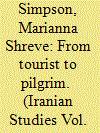| Srl | Item |
| 1 |
ID:
093496


|
|
|
|
|
| Publication |
2010.
|
| Summary/Abstract |
The paper begins by summarizing the basic information about the Shahnama produced in Herat for the Timurid prince Baysunghur, son of Shah Rukh, in 833/1430, one of the three iconic illustrated versions of Firdausi's poem in Persian painting. It then considers in turn the originality of this manuscript, its iconographic program and the intervals at which the images are placed within the text. The themes of enthronement and combat or battle are explored at length, as are the page layout, the role of illumination and the technique and execution of the paintings.
|
|
|
|
|
|
|
|
|
|
|
|
|
|
|
|
| 2 |
ID:
093490


|
|
|
|
|
| Publication |
2010.
|
| Summary/Abstract |
Rustam is famed for being one of the most fleshed-out characters of the Shahnama. As such, this article will analyze an episode in his life of extreme emotional turbulence, in order to gain a closer understanding of how much realism Firdausi bestows upon his characters. This episode is the suicide attempt he makes following his act of filicide. I will begin with a discussion of the difficulties involved in interpreting such an ancient text as the Shahnama. An analysis of Rustam's background follows, tracing the development of his personality. I will then take a detailed look at the circumstances surrounding his attempted suicide. After this, I will gauge the extent to which this act may have its roots in his personality. By thus examining how realistic is Rustam's suicide attempt, I hope this paper will contribute to the further study of the literary nature of Firdausi's Shahnama.
|
|
|
|
|
|
|
|
|
|
|
|
|
|
|
|
| 3 |
ID:
093498


|
|
|
|
|
| Publication |
2010.
|
| Summary/Abstract |
Notwithstanding its brevity, Firdausi's account of Iskandar's visit to the Ka'ba in Mecca was depicted regularly in illustrated manuscripts of the Shahnama from the fourteenth century to early modern times. An examination of these illustrations reveals the extent to which poetical and pictorial narratives diverged over the centuries, with an increasing expansion of the shrine's setting and emphasis on ritual performance and with Iskandar evolving from a passive bystander to a devout hajji. This study also offers a telling instance of the way the representation of a Shahnama scene could be transformed in response to another poetic text, specifically the Khamsa of Nizami.
|
|
|
|
|
|
|
|
|
|
|
|
|
|
|
|
| 4 |
ID:
093484


|
|
|
|
|
| Publication |
2010.
|
| Summary/Abstract |
The paper reconsiders the apocryphal stories regarding the Shahnama's initial reception to propose that it was only after long narrative poems gained currency that the Shahnama was recognized as a masterpiece. The paper analyzes the structure and themes of several histories written before and during the Samanid period and compares them with the Shahnama and the content of histories and epics produced immediately afterwards, to argue that the initial reception of the Shahnama did not depend on Sultan Mahmud Ghazni alone. It further argues that the Shahnama's aim, content, and execution differed from the histories and poetry produced in the decades immediately preceding and succeeding it, which would account for the lag in its acceptance and popularity. This led later biographers to superimpose their regret over Firdausi's treatment onto Sultan Mahmud Ghazni, who by their accounts denied him the fame and glory he deserved in his lifetime.
|
|
|
|
|
|
|
|
|
|
|
|
|
|
|
|
| 5 |
ID:
093492


|
|
|
|
|
| Publication |
2010.
|
| Summary/Abstract |
In this literary analysis of the Akvan Div story in the Shahnama, the author proposes to read the story through the lens of more ancient texts to arrive at a better understanding of the trickster "archetype" in Iranian culture. After a brief introduction to and critique of Jungian archetypal theory and some remarks on the proposed method of "etymological reading," a structural summary of the story is offered. The analysis that follows shows that in this reading, the story appears in its unity and parts that are usually seen as epic digressions become meaningful.
|
|
|
|
|
|
|
|
|
|
|
|
|
|
|
|